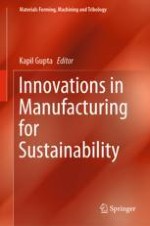
2019 | OriginalPaper | Chapter
Dry and Near-Dry Machining Techniques for Green Manufacturing
Authors : Sujan Debnath, Moola Mohan Reddy, Alokesh Pramanik
Published in: Innovations in Manufacturing for Sustainability
Publisher: Springer International Publishing
Activate our intelligent search to find suitable subject content or patents.
Select sections of text to find matching patents with Artificial Intelligence. powered by
Select sections of text to find additional relevant content using AI-assisted search. powered by